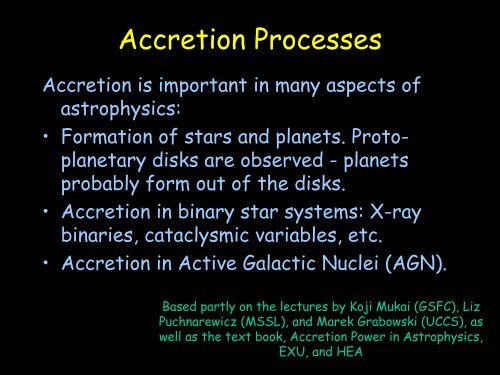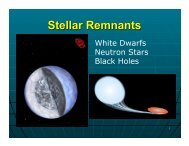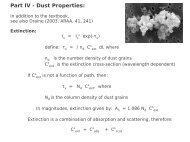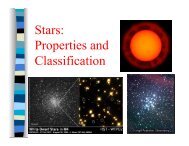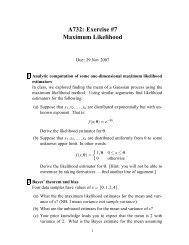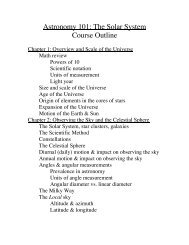Accretion phenomena and theories
Accretion phenomena and theories
Accretion phenomena and theories
Create successful ePaper yourself
Turn your PDF publications into a flip-book with our unique Google optimized e-Paper software.
<strong>Accretion</strong> Processes<br />
<strong>Accretion</strong> is important in many aspects of<br />
astrophysics:<br />
• Formation of stars <strong>and</strong> planets. Protoplanetary<br />
disks are observed - planets<br />
probably form out of the disks.<br />
• <strong>Accretion</strong> in binary star systems: X-ray<br />
binaries, cataclysmic variables, etc.<br />
• <strong>Accretion</strong> in Active Galactic Nuclei (AGN).<br />
Based partly on the lectures by Koji Mukai (GSFC), Liz<br />
Puchnarewicz (MSSL), <strong>and</strong> Marek Grabowski (UCCS), as<br />
well as the text book, <strong>Accretion</strong> Power in Astrophysics,<br />
EXU, <strong>and</strong> HEA
<strong>Accretion</strong> onto a compact object<br />
• Principal mechanism for producing high-energy<br />
radiation<br />
• Most efficient of energy production known in the<br />
Universe.<br />
• Gravitational potential energy released for an object<br />
with mass M <strong>and</strong> radius R when mass m is accreted:<br />
– E acc = GMm/R = (R s /2R)mc 2<br />
where R sch<br />
= 3 M sun<br />
km<br />
– For a Neutron star, R ~ 10 km E acc ~ 0.15 mc 2<br />
Or ~ 20 x more efficient than nuclear fusion<br />
(H => He) ~ 0.007 mc 2 .<br />
– For a white dwarf, R ~ 10 4 km E acc ~ 1.5x10 -4 mc 2<br />
Or ~ 50 less efficient than nuclear fusion.
Origin of accreted matter<br />
• Given M/R, luminosity produced depends on<br />
accretion rate, dm/dt:<br />
L acc = dE acc /dt = GM (dm/dt)/R . = (R sch /R)(dm/dt)c 2<br />
• Consider a neutron star with an observed X-<br />
ray luminosity of 10 38 .<br />
ergs/s, the required<br />
mass accretion rate dm/dt = 10 -8 M sun /year<br />
• Where does accreted matter come from?<br />
– Companion? Yes.<br />
– ISM? Too small to explain observed accreting<br />
compact objects of stellar masses. But enough for<br />
AGNs --- accreting supermassive black holes with<br />
masses 10 6 -10 10 M sun
The Eddington Luminosity<br />
M<br />
• A limit to which luminosity can be produced by a<br />
given object, assuming a steady accretion state.<br />
• The inward gravitational force on matter is balanced<br />
by the outward transfer of momentum by radiation.<br />
• At this point accretion stops, effectively imposing a<br />
‘limit’ on the luminosity of a given body.<br />
r<br />
Electrostatic forces<br />
between e - <strong>and</strong> p binds<br />
them so act as a pair<br />
m F grav =GMm/r 2 where m=m p +m e ~ m p<br />
F grav F rad<br />
= Lσ T /(4πr 2 c)<br />
F rad = [L/(4πr 2 hν)]σ T (hν/c)<br />
F grav = F rad the Eddington luminosity<br />
L= 4πcGMm/σ T<br />
=1.3 x10 38 (M/M sun ) ergs/s
Emitted Spectrum<br />
• Define temperature T rad such that hν~kT rad<br />
• Define ‘effective’ BB temp<br />
T b =[L acc /(4πR 2 σ)] 1/4<br />
• Thermal temperature, T th such that:<br />
GMm/R = 2x 3/2 kT th T th =GMm/(3kR)<br />
Flow optically-thick:<br />
T rad ~ T b<br />
Flow optically-thin:<br />
T rad ~ T th
Spectrum<br />
In general, T b < T rad < T th<br />
• For a neutron star with<br />
L acc ~1.3x10 38 (M/M sun ) ergs/s<br />
– T th ~ 5 x 10 11 K ~ 50 MeV<br />
– T b ~ 2 x 10 7 K ~ 1 keV<br />
Therefore, 1 keV < hν < 50 ΜeV<br />
=> X-ray <strong>and</strong> γ-ray sources<br />
• Similarly for a stellar mass black hole<br />
• For white dwarf, L ~10 33 ergs/s, M~M sun ,<br />
R=5x10 3 km,<br />
6 eV < hν < 100 κeV<br />
=> optical, UV, X-ray sources
<strong>Accretion</strong> modes in binaries<br />
Consider binary systems which contain a<br />
compact star, either white dwarf, neutron<br />
star or black hole.<br />
(1) Roche Lobe overflow<br />
(2) Stellar wind<br />
- correspond to different types of X-ray<br />
binaries
Roche Lobe Overflow<br />
• normal star exp<strong>and</strong>ed or binary separation<br />
decreased => normal star feeds compact<br />
M 1<br />
M 1<br />
a<br />
CM<br />
+<br />
M 2<br />
M CM 2<br />
+<br />
v<br />
Compact star M 2 <strong>and</strong><br />
normal star M 1<br />
M 2 >M 1<br />
L1<br />
Sections in the orbital plane<br />
of Roche equipotentials
<strong>Accretion</strong> disk formation<br />
Matter circulates around the compact<br />
object:<br />
ang mom<br />
outwards<br />
matter<br />
inwards
• Material transferred has high angular<br />
momentum so must lose it before accreting<br />
=> disk forms<br />
• Gas loses ang mom through collisions,<br />
shocks, viscosity <strong>and</strong> magnetic fields:<br />
kinetic energy converted into heat <strong>and</strong><br />
radiated.<br />
• Matter sinks deeper into gravity of<br />
compact object
Magnetic fields in ADs<br />
Magnetic “flux tube”
Mag field characteristics<br />
• Magnetic loops rise out of the plane of<br />
the disk at any angle – the global field<br />
geometry is “tangled”<br />
• The field lines confine <strong>and</strong> carry plasma<br />
across the disk<br />
• Reconnection <strong>and</strong> snapping of the loops<br />
releases energy into the disk<br />
atmosphere – mostly in X-rays<br />
• The magnetic field also transfers<br />
angular momentum out of the disk<br />
system
<strong>Accretion</strong> disk structure<br />
R<br />
The accretion disk<br />
(AD) can be<br />
considered as rings<br />
or annuli of<br />
blackbody emission.
<strong>Accretion</strong> disk structure<br />
Consider a cylinder<br />
of an inner radius r<br />
<strong>and</strong> outer radius<br />
r+∆r <strong>and</strong> a surface<br />
mass density of Σ.<br />
M *<br />
r<br />
G(r)<br />
G(r+∆r)<br />
The torgue on the inner cylindrical<br />
surface is<br />
G(r)=-2πr 2 νΣr(dΩ/dr)<br />
On the outer surface G(r+∆r) in the<br />
opposite direction<br />
The net torgue on the cylinder is<br />
then ∆G(r)=G(r+∆r)-G(r)<br />
∆G(r) = ∆(dL/dt) where dL/dt=r 2 Ω<br />
(dm/dt)<br />
Integration gives -2πr 2 νΣr(dΩ/dr)<br />
=dL/dt(r)-dL/dt(r in )<br />
Since Ω ∝r -3/2 for a Keplerian disk,<br />
νΣ=(dm/dt)/(3 π)[1-(r in /r) 1/2 ]
<strong>Accretion</strong> disk structure (cont.)<br />
Energy loss per unit area:<br />
dE/dt=νΣr 2 (dΩ/dr) 2 /2<br />
=(3GM * dm/dt)/(8πr 3 )[1-(r in /r) 1/2 ],<br />
where 2 is due to the two sides of a disk.<br />
The luminosity of the disk<br />
L=∫(dE/dt)4πrdr=GM(dm/dt)/(2r in )=1/2L acc<br />
Another half of the potential energy is kinetic, ie.<br />
1/2mv 2 =1/2m(GM/r in )=1/2L acc<br />
Assuming BB,<br />
dE/dt=σT 4 (r)<br />
T(r)={(3GM * dm/dt)/(8πr 3 σ)[1-β (r in /r) 1/2 ]} 1/4<br />
=T in {(r in /r) 3 [1-β (r in /r) 1/2 ]} 1/4<br />
where β is due to the inner boundary cond.
Disk spectrum<br />
Flux as a function of frequency, ν<br />
Total disk spectrum<br />
Log ν*F ν<br />
Annular BB emission<br />
Log ν
Complications<br />
X-ray UV optical<br />
bulge<br />
Hot, optically-thin<br />
inner region; emits<br />
bremsstrahlung<br />
Outer regions are cool,<br />
optically-thick <strong>and</strong> emit<br />
blackbody radiation<br />
• The other half of the accretion luminosity is<br />
released at the inner boundary <strong>and</strong> may partly be<br />
used to spin-up the compact star. Emission is<br />
often from optical thin, high temperature corona.<br />
• Nuclear burning of matter accumulated on the<br />
surface can provide additional luminosity.
Stellar Wind Model<br />
Early-type stars have intense <strong>and</strong> highly supersonic<br />
winds. Mass loss rates – 10 -6 to 10 -5 M sun /year.<br />
For compact star – early-type star binary, compact<br />
star accretes if GMm/r > 1/2mv rel2 , where v rel2 =<br />
(v w2 +v ns2 )<br />
Therefore, r acc =2GM/v rel<br />
2<br />
V w<br />
r acc<br />
This process (Bondi-<br />
Holye accretion) is much<br />
less efficient than<br />
Roche lobe overflow, but<br />
mass loss rates high<br />
enough to explain<br />
observed luminosities.<br />
bow shock<br />
matter collects in wake<br />
V ns
<strong>Accretion</strong> onto a magnetic star<br />
White Dwarfs <strong>and</strong> Neutron Stars can posses strong<br />
magnetic field. Assuming spherical accretion <strong>and</strong> a<br />
dipole-like B field, B ~ µ/r 3 , where the magnetic<br />
moment µ=B * R *3 is a const.<br />
• Magnetic pressure P m =B 2 /8π<br />
• Ram-pressure of the accretion flow<br />
P r =(ρv)v = [dm/dt/(4πr 2 )](2GM * /r) 1/2<br />
• P m =P r => Alfven Radius r m =<br />
(5.1 ×10 3 km)[(dm/dt)/10 16 ) -2/7 (M * /M sun ) -1/7 (µ/10 30 ) 4/7 ,<br />
where dm/dt is related to the accretion<br />
L acc =GM * (dm/dt)/R * .<br />
• Alfven Radius characterizes the inner radius of the<br />
accretion disk, if there is any.
• Gas captured from companion falls toward the<br />
compact star<br />
• The gas may spin around as an accretion disk<br />
before falling onto the star<br />
• Material is channeled along field lines <strong>and</strong> falls<br />
onto star at magnetic poles, where most<br />
radiation is produced X-ray or even γ-ray<br />
pulsators, X- bursters, etc.<br />
B-fieldline<br />
Soft<br />
X-ray<br />
Hard<br />
X-ray<br />
NS surface
Strong B field neutron Stars in binary systems
X-ray Binaries<br />
Type<br />
Donor star<br />
Compact<br />
object<br />
<strong>Accretion</strong><br />
disk<br />
Examples<br />
MXBR<br />
OB I-III<br />
NS,BH<br />
small<br />
Cen X-ray<br />
Be system<br />
Be<br />
NS<br />
Small<br />
A0535+26<br />
LMXB<br />
A-M V<br />
NS, BH<br />
yes<br />
Sco X-1<br />
LMXB<br />
WD<br />
NS<br />
yes<br />
4U1820-30<br />
CV (D.N.)<br />
K-M V<br />
WD<br />
Yes<br />
U Gem<br />
CV (Polar)<br />
K M V<br />
Mag WD<br />
No<br />
AM Her<br />
CV (I.P.)<br />
K-M V<br />
Mag WD<br />
Ring<br />
DQ Her<br />
EXU Section 7.2
Black Holes in General Relativity<br />
• The spherically symmetric solution for a single mass<br />
(Schwarzschild metric in natural units; G =c=1):<br />
ds 2 = - (1-2M/r) dt 2 + (1-2M/r) -1 dr 2 + r 2 dθ 2 + r 2 sin 2 θdφ 2<br />
• The Schwarzschild radius,<br />
R s<br />
= 2GM/c 2 ∼ 3 [M/( M sun<br />
)] km.<br />
defines the event horizon.<br />
– Once inside the event horizon, no light nor particle<br />
can escape to the outside: thus, J.C. Wheeler<br />
coined the term, black hole.<br />
– Objects just outside an event horizon are seen to<br />
experience severe time dilation by an observer at<br />
infinity.
• A singularity at the center of a black hole -- a<br />
point of infinite density, where the known laws of<br />
physics break down.<br />
• Black holes can have only three measurable<br />
properties: mass, spin, <strong>and</strong> charge.<br />
• Real black holes are unlikely to accumulate a<br />
significant charge, but spinning black holes<br />
(described by the Kerr metric) are highly likely.<br />
• By definition, black holes emit no radiation, except<br />
for the probably tiny Hawking radiation due to a<br />
quantum process that converts some of their mass<br />
into radiation (splitting virtual particle-antiparticle<br />
pairs)<br />
• They may be inferred from gravitational waves<br />
from double compact stars, binary systems with<br />
missing companion, X-ray emission from hot gas<br />
(10 6 K) in accretion disk
Origin of Stellar-mass Black Holes<br />
• Still very uncertain, but generally expected from E=mc 2 <strong>and</strong><br />
the attraction of the gravity.<br />
• No neutron stars can be more massive than 3M sun . Indeed,<br />
the masses of neutron stars as measured in binaries are all<br />
consistent with this prediction.<br />
• Thus for a star with a more massive core, one may expect<br />
them to collapse into a BH. The star, if single, must start<br />
off as a very massive star ( > 10-20 M sun ).<br />
• We do not know the exact mass limits for stellar mass black<br />
holes.<br />
• For black holes in compact binaries:<br />
– They need to survive the supernova explosion.<br />
– Binary evolution involves mass exchanges which can produce<br />
unusual stars <strong>and</strong> change binary separations.<br />
– A common envelope stage can cause spiraling in of the buried<br />
star.
BH vs. Neutron Star<br />
• No hard surface<br />
Softer spectrum<br />
• Smaller for BHs<br />
Fast variability<br />
• Greater GR effects<br />
last stable orbit<br />
R ~ 3r s
Mass Function<br />
• Kepler's third law<br />
P 2 = 4π 2 a 3 /[G(M 1<br />
+M 2<br />
)]<br />
– the orbital period P; binary separation a; the total mass of the<br />
binary M 1<br />
+ M 2<br />
(the ``primary'' + the ``secondary'')<br />
• If the radial velocities of the secondary (for example) can be<br />
measured (single-lined spectroscopic binary), for a circular<br />
orbit, the observed velocity follows<br />
V 2 = V 0 + K 2<br />
sin[ 2π/P (φ-φ 0<br />
)]<br />
– Where V 0<br />
is the systemic radial velocity <strong>and</strong> φ is the orbital phase<br />
– K = sini a2π M 2 1 /[(M 1 +M 2<br />
)P] is the semi-amplitude of the<br />
secondary (true orbital velocity times sini, where i is the binary<br />
inclination angle (0 if pole-on).<br />
• The mass function:<br />
f(M) = (M 1<br />
sini) 3 /(M 1<br />
+M 2<br />
) 2 = P K 23<br />
/(2πG)<br />
– The right side: only the measurable quantities.<br />
– The left side: several unknown quantities, which may be<br />
estimated using other methods (eg, star classification, eclipsing)
Black Hole Example: Cygnus X-1<br />
• Large X-ray luminosity? an accreting compact object.<br />
• No pulse or burst a black hole accretor with no hard<br />
surface <strong>and</strong> strongly misaligned B.<br />
• ``ultrasoft'' X-ray spectral shape a lack of hard<br />
surface, which would contribute an additional hard X-ray<br />
component.<br />
• Identified with an optical star, HDE 226868, in 1971:<br />
– presumably the mass donor of the compact object, undetected<br />
in visual light<br />
– a radial velocity variation with P=5.6 days <strong>and</strong> K 2<br />
∼ 50 km s -1<br />
– a blue supergiant expeted to have M 2<br />
∼ 30 M \odot<br />
if normal(?)<br />
– Then the unseen compact object probably has a mass of 15 M sun<br />
Therefore Cyg X-1 contains a stellar-mass black hole.
Soft X-ray Transients<br />
• Also known as X-ray Novae - a class of X-ray binaries:<br />
– Typically brighten by many orders of magnitude quickly<br />
– Then decay exponentially over the next several months.<br />
– Probably experience such outbursts once every few decades.<br />
• In quiescence, the mass-donor can be studied in detail<br />
• Typical orbital period of 5-20 hrs<br />
• Often low mass main sequence stars.<br />
• Seven so far seen to have K 2 of ~ 500 km s -1 a mass<br />
function > 3 M sun : they must contain a black hole<br />
primary, regardless of what the secondary is - i.e.,<br />
dynamically confirmed.<br />
• A higher fraction of soft X-ray transients appear to<br />
contain a black hole than X-ray binaries in general.
Other evidence for black holes<br />
• Evidence for frame dragging?<br />
– A rotating (Kerr) black hole causes<br />
precession of orbit around it.<br />
– Certain properties of Quasi-Periodic<br />
Oscillations (QPOs) seen in a black hole<br />
transient can be explained by such frame<br />
dragging.<br />
• Evidence for event horizon?<br />
– At low accretion rate, infalling gas may<br />
form an Advection Dominated <strong>Accretion</strong><br />
Flow (ADAF), which is very inefficient at<br />
radiating the thermal energy <strong>and</strong> carries<br />
the heat with it.<br />
– This may explain the low X-ray luminosity<br />
of SXTs in quiescence <strong>and</strong> of Sgr A*.
Micro-Quasar GRS1915<br />
• Radio images show one<br />
plasma bubble coming<br />
almost directly<br />
toward us at 90<br />
percent the speed of<br />
light, <strong>and</strong> another<br />
moving away. Each of<br />
the four frames<br />
marks the passage of<br />
one day.
Light Bending<br />
A simulated view of the<br />
constellation Orion with a black hole<br />
in front.<br />
Because of bending of<br />
light, the event<br />
horizon will cast a<br />
large shadow with<br />
an apparent<br />
diameter of ~ 5<br />
Schwarzschild radii;<br />
next generation<br />
radio VLBI may be<br />
able to see this for<br />
Sgr A*.<br />
Robert Nemiroff (MTU)
Our Galactic Center<br />
• more than 5000 km/s at a mere 17 light<br />
hours distance (S2) -- about 3x the size of<br />
our solar system -- through the periastron.<br />
MPE: www.mpe.mpg.de/www_ir/GC/gc.html<br />
•3.7±1.5 million solar masses within<br />
this distabce.<br />
•not possible to explain this mass<br />
with a neutrino ball model because<br />
the required neutrino masses<br />
would be too large, or with a dense<br />
cluster of dark objects because it<br />
would have the lifetime of at most<br />
a few 10 5 years.
Sagittarius A*<br />
• A compact radio source<br />
• believed to be at the dynamical center of<br />
our Galaxy<br />
• consistent with a super-massive black hole<br />
(SMBH) accreting at a modest rate<br />
• proper motions (projected motion on the<br />
plane of the sky) of stars within a light<br />
year of Sgr A*.<br />
• an unusually weak X-ray source


